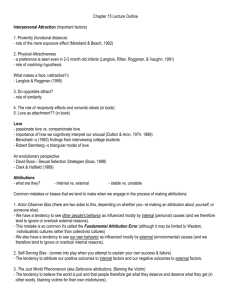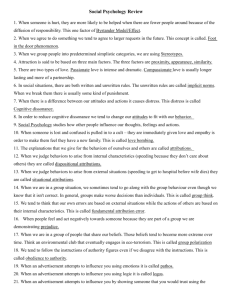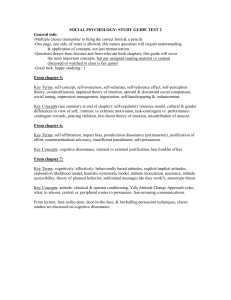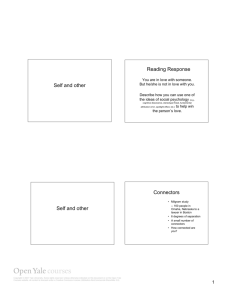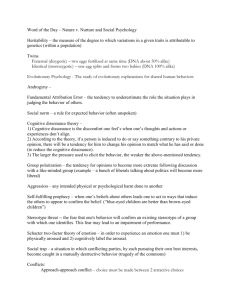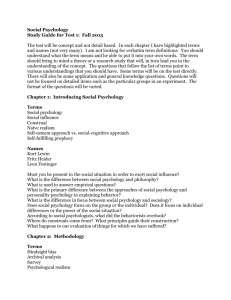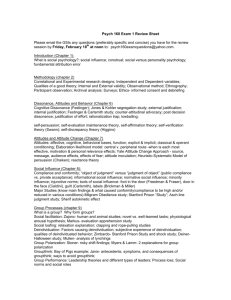f. cognition part 2
advertisement
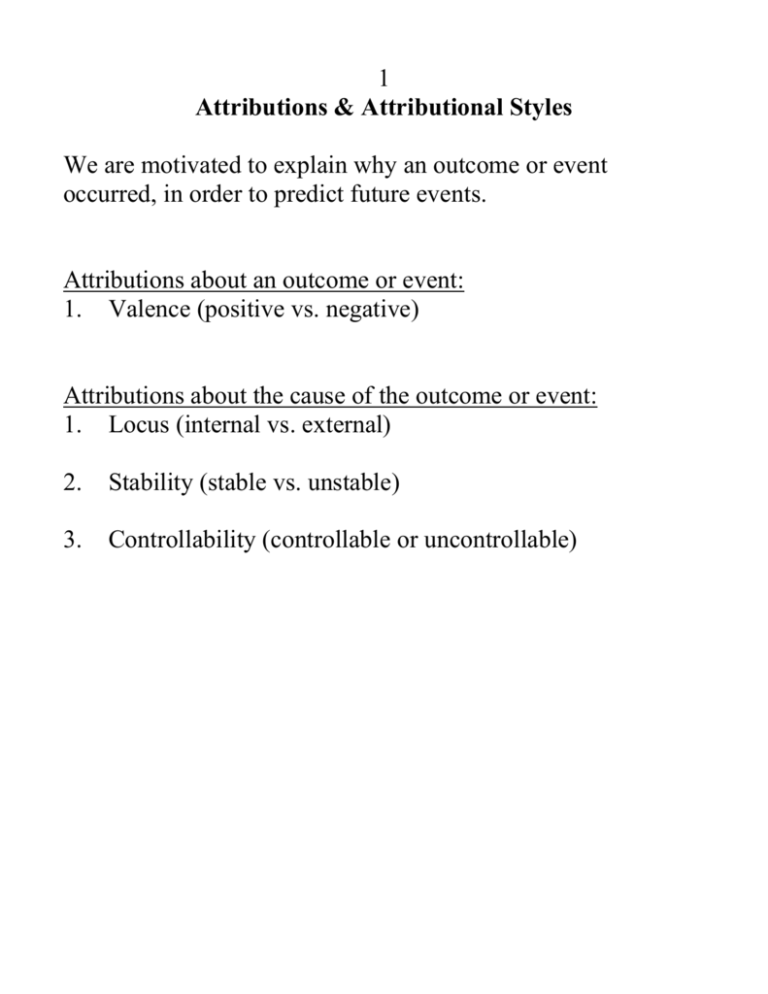
1 Attributions & Attributional Styles We are motivated to explain why an outcome or event occurred, in order to predict future events. Attributions about an outcome or event: 1. Valence (positive vs. negative) Attributions about the cause of the outcome or event: 1. Locus (internal vs. external) 2. Stability (stable vs. unstable) 3. Controllability (controllable or uncontrollable) 2 The Attributional Style Questionnaire Each item describes an event and takes into account: 1. Valence for each event 2. Locus of control, perceived stability, and controllability 3 Sample ASQ Item Instruction: please, try to vividly imagine yourself in the situations that follow. If such a situation happened to you, what would you feel would cause it? While events may have many causes, we want you to pick only one - the major cause if this event happened to you. Please, write this cause in the blank provided after each event. Next, we want you to answer some questions about the cause and a final question about the situation. YOU HAVE BEEN looking for a job unsuccessfully for some time. 1. Write down the major cause ................................................................................................................... 2. Is the cause of your unsuccessful job search due to something about you or to something about other people or circumstances? Totally due to other people or circumstances 1 2 3 4 5 6 7 Totally due to me 3. In the future when looking for a job, will this cause again be present? Will never again be present 1 2 3 4 5 6 7 Will always be present 4. Is the cause something that you can control, or is cause something over which you have little or no control? Little or no control 1 2 3 4 5 6 7 Totally in control 4 Optimistic vs. Pessimistic Attributional Styles Optimistic Styles (self-enhancing pattern, self-serving bias): Optimists tend to: 1. Attribute good events to stable & controllable causes 2. Form internal attributions for good events 3. Form external attributions for negative events 6 Pessimistic Styles (Self-effacing pattern): Pessimists tend to: 1. Attribute good events to unstable & uncontrollable causes 2. Form external attributions for good events 3. Form internal attributions for negative events 7 Research on Attributional Styles: Individual Differences Between Optimists and Pessimists Seligman & Schulman (1986) Peterson & Barrett (1987) Kamen-Siegel, Rodin, Seligman, & Dwyer (1991) Abela, & Seligman (2000) 8 Optimists Pessimists •have fewer doctor visits, sick days, •have more doctor visits, sick days, infectious illnesses infectious illnesses •seek treatment when sick •are more passive when sick •engage in healthy behaviors more frequently •engage in healthy behaviors less frequently •live longer •do not live as long •have superior immune systems •show immnosuppression •perform better than expected in school •perform worse than expected in school •will seek help with academic difficulties •do not seek help with academic difficulties •fewer problems with depression •more problems with depression 9 Cognitive Dissonance Theory Cognition = element of knowledge Pairs of cognitions can be: 1. 2. Relevant Irrelevant Relevant cognitions can be: 1. Consonant = agree with one another, one follows the other 2. Dissonant = disagree with one another, one is the opposite of the other 10 Consonance vs. Dissonance Consonance = consistency between cognitions; a psychologically comfortable state Dissonance = Discrepancy between cognitions; a psychologically uncomfortable state The discomfort produced from discrepancy motivates dissonance reduction. The greater the magnitude of the dissonance, the greater the impetus to reduce dissonance. 11 Research on Cognitive Dissonance Free- Choice Brehm (1956) S’s rated eight different products (e.g., toaster or coffeemaker) for desirability. S’s were asked to choose ONE product from a set of two that they would like to keep. All S’s had to choose between two products that were either: 1. Close in desirability (difficult decision) 2. Not close in desirability (easy decision). After making a choice, S’s were allowed to re-rate the desirability of the two products. Chosen Amount of Product Change Not-Chosen Product Easy Decision No change No change Difficult Decision Rated more desirable Rated less desirable 12 Induced-Compliance Festinger and Carlsmith (1959). S’s performed a boring task for 1 hr. S’s were told that there were two groups in the experiment: 1. No introduction to the task (the one the S was in) 2. Introduction, where S’s are first told the task is enjoyable by someone who had just completed it The S is asked to tell the next person that the task is enjoyable and paid either $1.00 or $20.00 S’s then asked to evaluate the task by an interviewer: Ratings of task enjoyment Paid $1.00 Rated more enjoyable paid $20.00 Rated less enjoyable 13 Forbidden-toy Aronson & Carl Smith, (1963) Young children were given the opportunity to play with toys and were threatened with severe or mild punishment if they played with a very attractive toy. When asked at a later time to evaluate the attractive toy: Threat of punishment Ratings of toy attractiveness Mild Severe Rated less attractive Rated more attractive 14 Alternative Explanations & Revisions to Cognitive Dissonance Theory 1. Self-Perception theory (Bem, 1965, 1972) 2. Impression-Management Theory (Tedeschi, Schlenker, & Bonoma, 1971) 3. Self-Affirmation (Steele, 1988; Steele, Spencer, & Lynch, 1993).
